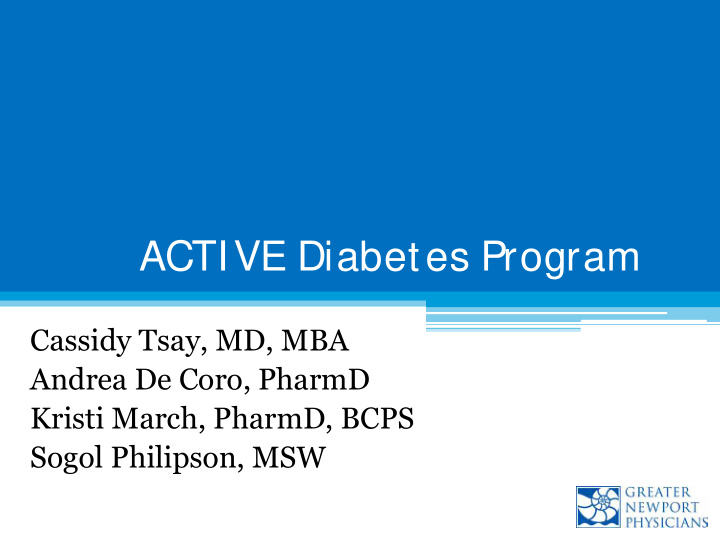



A CTIV E Diabetes Program Cassidy Tsay, MD, MBA Andrea De Coro, PharmD Kristi March, PharmD, BCPS Sogol Philipson, MSW
The Agenda • Vision ▫ Cassidy Tsay, MD, MBA • Development ▫ Andrea De Coro, PharmD • Implementation ▫ Kristi March, PharmD ▫ Sogol Philipson, LSW • Patient Perspective ▫ Pastor Michael Whitfield ▫ Margo Bennett
Polling question… Diabetes accounts for what percent of healthcare costs? a) 21% b) 14% c) 5% d) 30%
Why Diabetes? • Statistics ▫ 29.1 million people + 8.1 million undiagnosed ▫ Accounts for 14% of healthcare cost* Retinopathy, CAD, Strokes, Amputations, Kidney Failure, etc. • Impacts Everyone ▫ The Patient and the Family ▫ The Physician ▫ The Workplace • Statistics obtained from + Statistics obtained from CDC, www..cdc.gov/diabetes
The Vision • Team Approach to Care ▫ Provider ▫ Pharmacist ▫ Dietitian ▫ Social Worker ▫ Patient • Identify Barriers • Supportive Care • Mantras ▫ Allow people to do what they do best ▫ Communicate!
The ACTIVE Diabetes Program • A collaborative program between Hoag and GNP • Funded by Blue Shield of California
Development/ Learnings Andrea DeCoro, PharmD
If you build it, they will come? ACTIVE Diabetes Program
Patients! • Patient Recruitment ▫ Identification ▫ A1c’s move ▫ Outreach
Physicians • Physician Recruitment ▫ PCP’s ▫ Specialists ▫ Office Staff
Polling question What type of program/care does your facility provide for diabetes patients? a. Standard of care (PCP and endocrinologist) b. Diabetes group education (classes) c. Resources (websites, handouts, online materials) d. Multidisciplinary team approach e. Other
Learnings… • Top Three 1. Start with physicians and staff 2. Create seamless referral process 3. Advertise to patients differently
Implementation Kristi March, PharmD Sogol Philipson, MSW
What is the ACTIVE Diabetes Program? Com prehensive and Individualized Care Medication management (under protocol) by Clinical Pharmacist Psychosocial/stressors/motivation barriers identified/addressed Customized diet plan Foot exams, retinal screen, specialist referrals as needed Extension of service/support to physician/specialist plan
Key Elements Multidisciplinary team evaluation Individualized management plans Goal-setting/empowerment Follow-up in clinic or by phone/email All visit notes communicated to PCPs/specialists
Who can be referred to ACTIVE? Criteria: HbA1c 8 or above and struggling to manage their diabetes Can still refer if also being managed by endocrinologist
Who SHOULD be referred to ACTIVE? Good candidates: Need individualized education on diet/exercise Incessantly elevated A1c Barriers to monitoring sugar/insulin therapy Psychosocial issues/barriers Medications issues
Referral Process Mainly PCP driven Referrals sent through internal website Patients encouraged to call and make appointment
ACTIVE Patient Case 75 yo Male with A1c 12.5 (increased from 11.6 over past couple m onths) History of non-adherence with medications Admitted difficulty remembering medications Complaint of “frequent urination” (despite on Vesicare) Frustrated with high sugars so stopped checking Diabetes meds: glipizide and metformin
ACTIVE Patient Case ACTIVE Interventions: Education on glucometer/meds/pill box Weekly visits until adherence improved After 2 months: reduce glipizide (hypoglycemia episodes) No need for Vesicare A1c im proved to 7.7 LDL im proved to 93(from 123)
ACTIVE Diabetes Measures Optim al Diabetes Care Measures HbA1c under 8 Blood pressure under 140/90 LDL under 100 Nephropathy screen in past year
ACTIVE 2nd QTR 2014 Results (275 patients) 2 nd Quarter 20 14 Metrics Baseline Hemoglobin A1c < 9 82% 30% Hemoglobin A1c < 8 63% 2% (Average initial A1c is 10) Blood Pressure under 140/90 92% 88% LDL under 100 77% 63% Microalbuminuria screening 87% N/A
ACTIVE - Patient Satisfaction Provider Rating (out of 5) Nurse Practitioner 4.6 Clinical Pharmacist 4.9 Dietitian 4.5 Case Manager Social 4.4 Worker OVERALL 4.6
Polling Question What percent of diabetes in undiagnosed? a. 29.1 million b. 1.5 million c. 14.2 million d. 8.1 million
Double D’s Diabetes and Depression People with diabetes are twice as likely to have depression Depression = 60 % increased risk of developing type 2 diabetes
“DABDA” D enial A nger B argaining D epression A cceptance
“Prepare the soil AND then plant the seed” A person, NOT a “Diabetic” Empower/self care/goal-setting Identify and address barriers Depression screening/referrals Routine follow-up on all of the above Happy Birthday calls
Behind the scenes Case management Expedite referrals when appropriate Initial ACTIVE referral appointments
ACTIVE Patient Testimonials “…after my visit to you my life has taken on a whole new route. I have lost over 30 pounds and ALL my blood sugars are not short of a miracle. My (doctor) is totally blown away.” “I'm not used to such good interest in my health.” “…I felt so overwhelmed by diabetes requirements. I almost gave up hope of “managing” it… I felt it couldn’t be done. They (ACTIVE) felt it could be and kindly are teaching me how.”
Polling Question Which of the following statements are true? a. Depression causes diabetes b. Diabetes causes depression c. Diabetes and depression can be related d. Diabetes and diabetes are not related
“Tell me and I forget. Teach me and I remember. Involve me and I learn.” -Benjamin Franklin
Story Time https://portal.gnpweb.com/NewsEvents/Pages/Stories.aspx
Patient Perspective Pastor Michael Whitfield Margo Bennett
Questions?
Recommend
More recommend